1780 - Shipbuilding begins in Clackmannanshire.
It's thought that shipbuilding began in Clackmannanshire around 1780 on the northern shore of the Forth at Manor, which was part of Clackmannanshire until 1891. The cargo sloop 'Industry', built by Robert Duncanson, was launched there in June 1780. It was registered at Alloa in 1789 and operated until September 1843. The Manor site may have continued for a few years under Robert Johnstone.
Certainly by 1825 there was an established shipbuilding yard in Alloa, at Forth Street, as can be seen in the map below:

Part of John Wood 1825 Map
Alexander Duncanson
Alexander built sailing ships at Airth ('Lady Augusta', 1784) and Dunmore (1786 - 1797), before building at Alloa. The first ship he built at Alloa was the 'Charming Peggy', built in 1800. Nine more ships were built between 1800 and 1826, when the credit for building the ships at the Forth Street yard transferred to his nephew, John Duncanson.
John Duncanson
John continued shipbuilding at Alloa and built thirty-six ships between 1825 and 1853. In 1845 the company launched the 500 ton 'Lady Bruce', a name previously held by the brigantine cargo ship built in 1794 by James Gray at Kincardine.
Thomas Adamson
Thomas is credited with building ships at the former Duncanson yard from 1855. He had shipbuilding interests at several ports, including Grangemouth, where his company had been building ships since 1827. The company built thirty-nine ships at Alloa between 1855 and 1872, including the 'George Kidd' and the 'Earl of Mar and Kellie', their last ship being the 'Alloa'.
Roy & Mitchell
After Thomas Adamson's retiral Roy & Mitchell bought the yard, producing seven ships between 1873 and 1880.
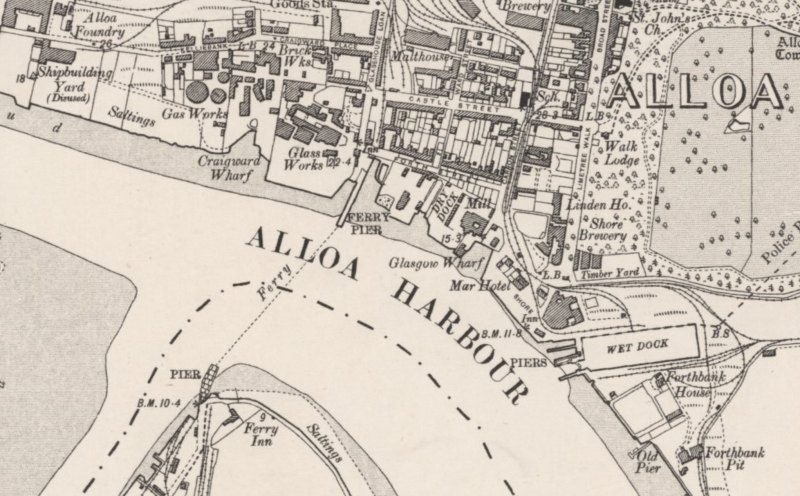
Map from late 1800's or Early 1900's - showing Kelliebank yard (left) and the yard and dry dock at Forth Street (centre)
Andrew Thomson and Sons
In 1883, Andrew Thomson and Sons built two unpowered barges, 'Glen Tower', for Distiller's Company and 'Devon', but it was not until 1889 when the Grangemouth dockyard took over the Kelliebank Yard that the next ship was built in Alloa.
Grangemouth Dockyard Company
The Grangemouth Dockyard Company was a shipbuilding and ship repair company based at Grangemouth, on the Firth of Forth, Scotland. The company was established in 1885 by William Miller and Samuel Popham Jackson. The company acquired another two yards in 1888, located in Alloa and Ardrossan.
Grangemouth Dockyard Company are credited with building twenty-one ships at Kelliebank, Alloa (to the west of the Duncanson shipyard) between 1889 and 1892. The steamer 'Godolphin' was built in 1889 at Kelliebank. The 'North Star' was built in 1892 and sunk by a U-boat (U-96) in October 1917.
H. McIntyre & Company
H. McIntyre & Co. built four vessels at Kelliebank between 1894 and 1895, 'St Gothard', a fishing trawler, 'Princess Louise', and Paddle steamers 'Aguila and 'Cambria'. The company went into liquidation in 1902.
A. Jeffrey and Co. Ltd
A. Jeffrey and co. Ltd was established in 1876 as a blacksmith in Forth Street near the 'wet dock'. There was a need for blacksmith work on many of the sailing ships arriving in South Alloa to unload pit-props. These ships came mostly from Baltic ports and were often lacking in the ironwork necessary for safety of the sails and the masts-bands. The owners were binding the rigging and masts with rope and bringing the ships to Alloa for the ironwork to be done as it was cheaper to have the work done at Alloa than back home. The company moved onto the site of the old Duncanson's shipyard in 1890 and acquired the old stone dry dock in 1904. After the death of Archie Jeffrey in 1907 the company was restructured and by 1911 started shipbuilding.
After their first two ships, 'Innismurray' and 'Innisnee', orders were obtained for three unpowered barges for use on the Thames. They became very successful in building steel ships and steam engines, building a further fifteen vessels between 1913 and 1918. By 1916 a London financial group owned 50% of the company and in return they had the capital available to build ships larger than 2,000 tons.
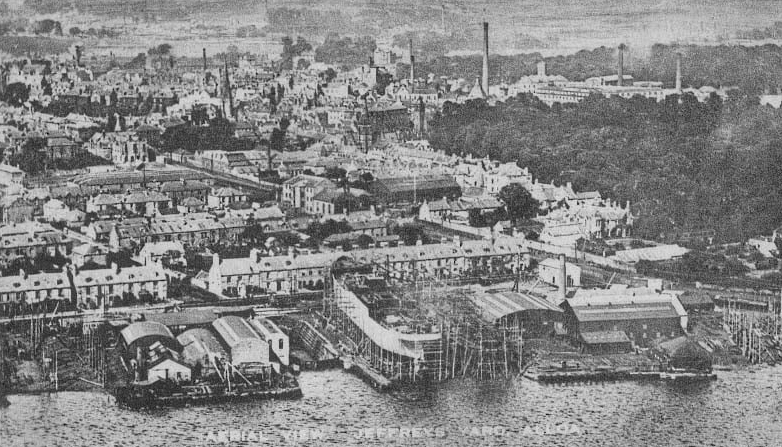
Mackay Brothers
Peter and Donald Mackay bought Kelliebank Shipyard in 1902. They went on to produce twenty-one steamers, both cargo and passenger, from 1905 until 1914 when they too went out of business. They sold the yard to Mr H. Buckland in 1914.
Forth Shipbuilding and Engineering Company Ltd
incorporated in 1916 and built ships initially from the Kelliebank yard. In 1918 an independent entrepreneur, financier and arms dealer, Sir Basil Zaharoff - who was working with Vickers Ltd on this project - bought A. Jeffrey and Co. Ltd and the Kelliebank Shipyard and soon after constructed a new yard at Forth Bank. This company, The Forth Ship Building and Engineering Company - now owned by Vickers Ltd - developed rapidly. During the early 1920's ships ranging between 4,000 and 8,000 tons were built. Two 13,000 ton vessels were the largest produced in the east of Scotland at that time. Many of the orders came from Norway. During the economic slump of the 1920's, all but one of the Norwegian companies who had orders with the Alloa company had to be wound up. The company went into voluntary liquidation in 1921.
A successor, Forth Shipbuilding and Engineering Co. (1921) Limited was incorporated and the yard made a number of larger shelterdeckers and a coastal liner for the London and Edinburgh Shipping Co. The yard went on to build two large cargo-liners for a Dutch company. Vickers closed the yard down in 1923 due to the slump in freight rates, completing its last ship Ravnefjell for a Norwegian company, before the company went into voluntary liquidation in 1927.
Tank Landing Craft
During World War II, engineering company Sir William Arrol and Co. were commissioned by the UK Government to make Mark 4 and Mark 8 Tank Landing Craft at Glasgow and Alloa. The company ran the Kelliebank shipyard, whilst the Forthbank yard was managed by the Motherwell Bridge and Engineering Co.
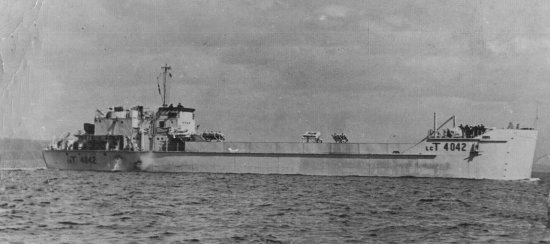
Arrol - built LCT 4042 after commissioning at Leith
These ventures were only ever meant to last for the remainder of the war and so Kelliebank yard and Forthbank yard closed at the end of the war.
Sir William Arrol and Co.
Founded around 1872, Sir William Arrol & Co. was a leading Scottish civil engineering and construction business founded by William (later Sir William) Arrol, which was based in Glasgow. The company built some of the most famous bridges in the United Kingdom including the second Tay Bridge, the Forth Rail Bridge and Tower Bridge in London.
Construction of the replacement Tay Bridge was started in 1882 and it opened in 1887. Almost simultaneously, William Arrol was also working on the Forth Rail Bridge. Construction began in 1882 and when it was opened in 1890 it had the longest single cantilever bridge span in the world. William Arrol’s commitment to these two bridges was rewarded with a knighthood: Sir William Arrol & Company Ltd was incorporated in June 1893.
Also arising out of Arrol's Dalmarnock Works and bridge building were cranes. particularly for shipbuilding. The most famous crane, the largest of its time, was the Titan Crane completed in 1907; a gigantic cantilever crane of 150-ton capacity for John Brown & Company.
The company were aware of the yards at Alloa, as they had been called to repair the nearby rail bridge at Alloa on two occasions where ships had struck and damaged the bridge.
Many of the landing craft were overhauled, refitted or converted for other uses by McLeod's at their shipyard on Forth Street.
Many of the landing craft built at Alloa took part in the D-Day landings of June 1944. Very few landing craft from this era still survive.
McLeod Ship Repairing and Boilermaking
On the death in 1910 of local ferry owner Alexander McLeod, the company assumed the name McLeod and Sons.
In 1925 they acquired the shipyard at Forth Street and carried on with their business of boilermaking, ship repairing and general engineering, including electric welding. They also took contracts to strip and break up vessels, as well as maintenance and refitting of ships.
Around 1935 the firm came under the management of William McLeod. The firm refitted and repaired many distinguished ships in the 1940's, including the cable ship 'Dunavon' - used in laying the PLUTO pipeline under the English Channel in 1944 to supply fuel to the Allied invasion forces in Europe.
HMS Brittany, a former channel ferry, was repaired after serving in the Far East and the Mediterranean. The Dance Class Anti-Submarine vessel, HMS Saltarelo was refitted in 1942. Also fitted were the minelayer HMS Redshank, and HMS Romney which took part in the longest minesweep in naval history, were active in the recapture of Tobruk, and in the Sicily and the Anzio landings.
During the Second World War, the shipyard converted and refitted about 300 vessels.
However, the port of Alloa had declined by the 1950's and McLeod & Sons Alloa shipyard closed in 1972.
Cox and Danks Ltd and Alloa Shipbreaking Company.
The battlecruiser SMS Moltke which was scuttled at Scapa Flow, Orkney after World War I, was raised in 1927 by Cox and Danks Ltd and towed 280 miles to Rosyth upside down, where she was then broken up by the Alloa Shipbreaking Company, who used facilities at Charlestown, Rosyth and Alloa.
Cox sold ten of the twenty-five destroyers raised at Scapa Flow to the Alloa Shipbreakers for £23,000, all broken up at Alloa. In July 1931 Ernest Cox sold his plant, goodwill, and salvage rights to the 28,000-ton battleship SMS Bayern to the Alloa Shipbreaking Company, which in 1929 changed the company name to Metal Industries.
In 1933 Metal Industries bought the Cox and Danks salvage operations at Scapa Flow and in 1949 bought the rest of Cox and Danks Ltd.
The three yards mapped (west to east)
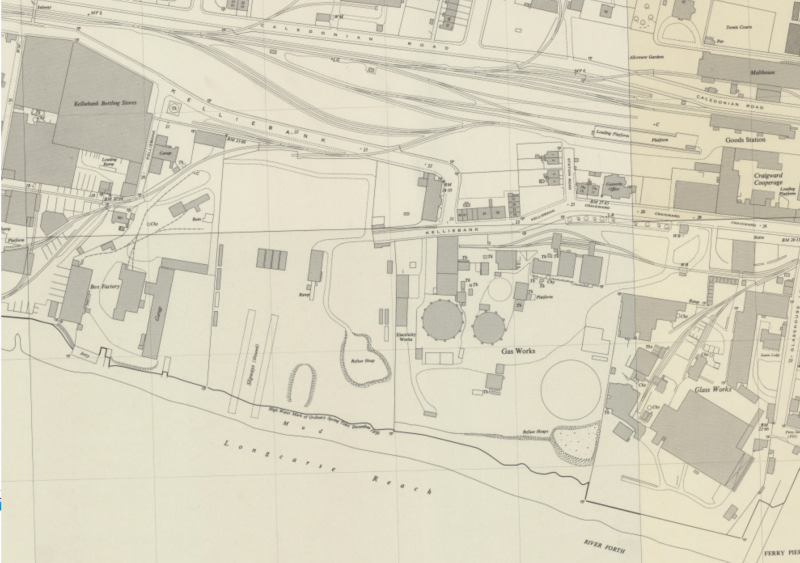
Kelliebank Yard - OS map
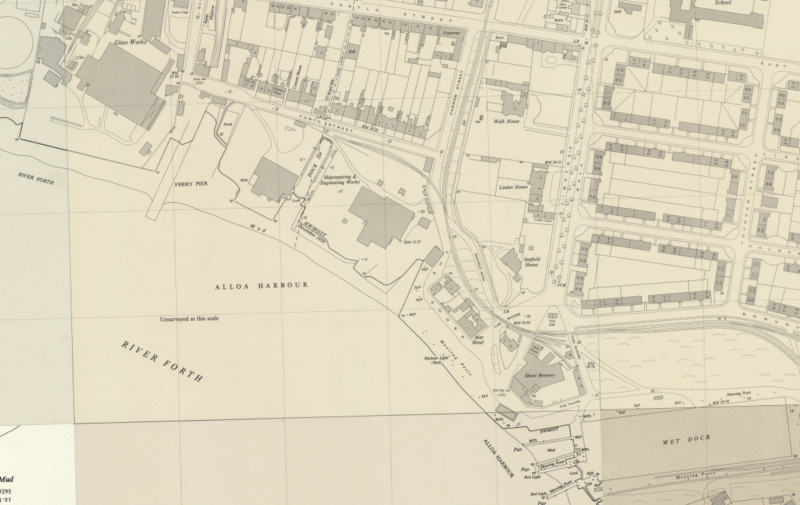
The Yard and Dock at Forth Street - OS Map

Forthbank Yard - OS Map
Information sources for this article include :
Forth Naturalist and Historian - Volume 15: Alloa, The Port, Ships and Shipbuilding - By Jannette Archibald (circa 1992)
Down by the Riverside - some notes on the history of the Alloa riverfront and of the Jeffrey Shipyard - by D.C. Jeffrey and Robert Jeffrey (1984)
www.clydeships.co.uk and several smaller internet sources.
